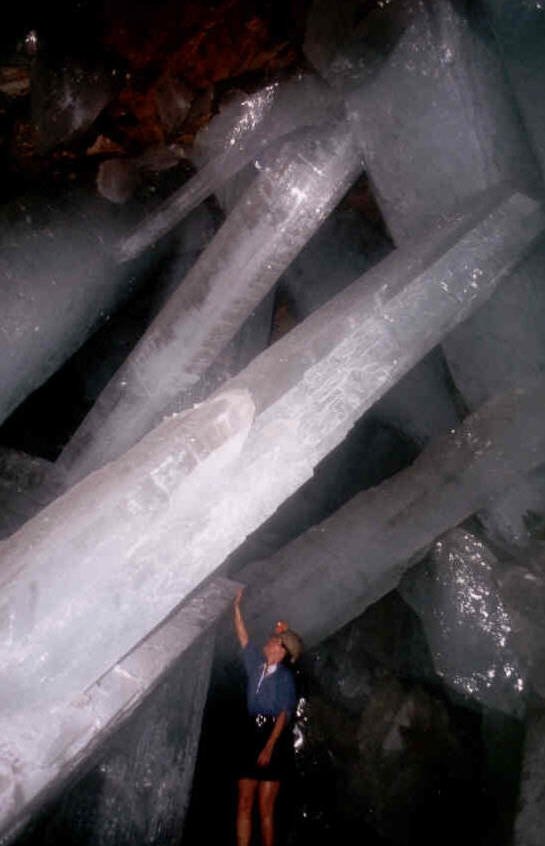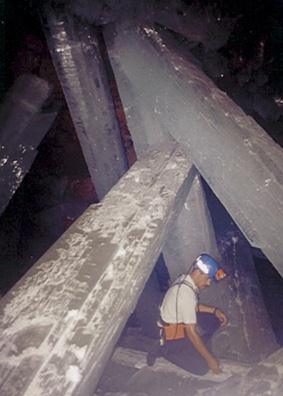English
Castellano
Català
Giant Selenite Crystals
Content by courtesy of: The Giant Crystal Project
Reproduction of text and photos prohibited without permission of author.
Permission to republish these information on the Giant Crystal Project Site was kindly given by Dave Tucker of Datamine / UK
This article is based on a report in a Mexican newspaper. It has been translated into English and edited by two of the staff at the Peñoles Naica mine who have also provided some additional facts and figures. Many thanks to :
- Martin Orozco, Geologist
- Roberto Villasuso Martinez, Superintendent of Exploration
Naica Crystal Caves
Deep below the surface of an isolated mountain range in Mexico sit two rooms of splendor: translucent crystals the length and girth of mature pine trees lie pitched atop one another, as though moonbeams suddenly took on weight and substance. In April 2000, brothers Eloy and Javier Delgado found what experts believe are the world's largest freestanding crystals while blasting a new exploration tunnel deep in the silver, lead and zinc Naica Mine of southern Chihuahua. After discovering a small opening about 300 metres down, Eloy squirmed inside and found an 8 metre cavern full of immense crystals. One and a half months later, another team of Naica miners happened upon an even larger cavern adjacent to the first one. Geologists conjecture that a chamber of magma, or superheated molten rock, lying two to three miles underneath the mountain forced mineral-rich fluids upward through a fault into openings in the limestone bedrock near the surface. Over a period of time, maybe more than 30 million years, this hydrothermal liquid deposited sulphides rich in silver, lead and zinc on the limestone bedrock. These metals have been mined here since prospectors discovered the deposits in 1794 in a small range of hills south of Chihuahua City. In addition, the hydrothermal fluids dissolved gypsum, the same material used in wallboard and plaster of paris, located in the bedrock. Hot, mineral-rich solutions gave birth to these giant selenite crystals.
Geologists conjecture that a chamber of magma, or superheated molten rock, lying two to three miles underneath the mountain forced mineral-rich fluids upward through a fault into openings in the limestone bedrock near the surface. Over a period of time, maybe more than 30 million years, this hydrothermal liquid deposited sulphides rich in silver, lead and zinc on the limestone bedrock. These metals have been mined here since prospectors discovered the deposits in 1794 in a small range of hills south of Chihuahua City. In addition, the hydrothermal fluids dissolved gypsum, the same material used in wallboard and plaster of paris, located in the bedrock. Hot, mineral-rich solutions gave birth to these giant selenite crystals.
In addition to 1 metre diameter columns 15 meters in length, the cavern contains row upon row of shark-teeth-shaped formations up to 1 metre high, which are positioned at odd angles throughout the cave. Until April 2000, mining officials had restricted exploration on one side of the fault out of concern that any new tunnel might lead to flooding of the rest of the mine. Only after the water table had dropped sufficiently did they authorize the tunnel that led to the Sanchez brothers' astonishing discovery.
Previously, the world's largest examples of selenite crystals came from a nearby cavern discovered in 1910 within the same Naica cave complex. Several examples from the Cave of Swords are exhibited at the Janet Annenberg Hooker Hall of Geology, Gems, and Minerals at the Smithsonian's National Museum of Natural History.

Giant Selenite crystals in the Naica mine, Mexico
Some additional facts and figures:
- The size of the cave is almost 50m long by 30m wide. The cave includes crystals 1.5 m high with sharp sides, and the biggest crystals are like rafters more than 12m long and 0.60m thick.
- The men who discovered the cave were the brothers Eloy and Javier Delgado
- The first cave discovered was called Eye of the Queen, because it has a little entrance, and seems like a human eye. The original first cave is 20m in length by an average of 10m wide. This cave is not yet open to the public.
- For the crystals to form, you must have two principal conditions - first the formation of the cave, and then the formation of the crystals.

- The formation of the cave is related to the circulation of underground water along the fault or fracture system dissolving the calcium carbonate of the limestone, and creating a cave.
- The crystals formation process is more complicated because it depends on temperature, pressure, geochemistry and the fluctuation of the aquifer within the cave. The thermal water, rich in sulfuric acid by the action between water and the oxidation of lead and zinc sulfur, ascends across the fractures and gets the carbonate by dissolution of the limestone. Upon reaching super-saturation the precipitation and crystallization of calcium sulfate started. We think that growing the crystals took more than 30 years if there wasn't a change in the cave conditions.
- The formation of the cave is related to the circulation of underground water along the fault or fracture system dissolving the calcium carbonate of the limestone, and creating a cave.
- Exploration is going on beside the fault, but we are trying to preserve the cave. My personal appreciation is that we have more caves like this undiscovered.
- We are doing an investigation in conjunction with the Granada University from Spain and doing a test lab with UTEP from El Paso, to try and explain the formation of the crystals.
- We are going to do an engineering project to maintain the original conditions of the cave before it is open to the public. The mine is on both sides of the fault, but the cave area is protected.
- The cave doesn't have any water. The water is going down to the lowest levels of the mine and is pumped to the surface. Actually we are pumping 14,000 gallons per minute of hot water (54°C).
- The cave is open under restricted visitation to the public, but for the moment just for scientists, geologists, mineralogists or anyone who has interest in admiring the marvelous crystals without damage.
Content by courtesy of: The Giant Crystal Project![]()
Information | Mineral photos | VIDEOS | Articles | Fairs | Web directory | Classified ads | Minerals Books | Shop



